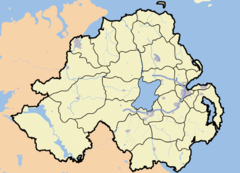Belleek
| Belleek | |
| Irish: Béal Leice | |
Belleek shown within Northern Ireland | |
| Coordinates: 54°28′56″N 8°05′12″W / 54.4821°N 8.0866°W | |
| Irish grid reference | |
|---|---|
| - Belfast | 104 miles |
| District | Fermanagh |
| County | County Fermanagh |
| Constituent country | Northern Ireland |
| Sovereign state | United Kingdom |
| Post town | ENNISKILLEN |
| Postcode district | BT93 |
| Dialling code | 028 |
| European Parliament | Northern Ireland |
| UK Parliament | Fermanagh and South Tyrone |
| NI Assembly | Fermanagh and South Tyrone |
| List of places: UK • Northern Ireland • Fermanagh | |
Belleek (from the Irish: Béal Leice meaning "mouth of the flagstone") is a village on the boundary between County Fermanagh (in Northern Ireland) and County Donegal (in the Republic of Ireland). The majority of the village is within County Fermanagh, making it the western-most village in the United Kingdom. It had a population of 836 people in the 2001 Census. It is situated within the Fermanagh District Council area.
Nowadays Belleek is a thriving market town with a variety of pubs, shops, restaurants and a hotel. It is most famous for the fine parian china produced there at the Belleek Pottery, the oldest pottery in Ireland. The china is valued by collectors from all over the world. It is also a noted location for angling and other recreational activities and is now linked to the River Shannon by canal.
The highest temperature in Northern Ireland recorded by the Met Office, 30.8°C, occurred at Knockarevan (near Belleek) in County Fermanagh on June 30 1976.[1]
History
In earlier times Neolithic settlers appeared around the town and legend has it that Fionn mac Cumhail's men sharpened their swords on the big limestone rock at Belleek Falls.
A royal castle was built at Caol Uisce near Belleek at the entrance to Lower Lough Erne by Gilbert Costello in 1212. Belleek Town in its present layout was founded on the Blennerhassett estate during the Plantation of Ulster in the early 1600s.
The establishment of the pottery in 1857 saw the start of growth and the town developed further with the founding of a cooperative creamery in 1899, a police station, a courthouse, post office and dispensary.
Places of interest
- The internationally renowned Belleek Pottery manufactured in the village is currently owned by American millionaire, George Moore. It was founded in 1857 by John Caldwell Bloomfield who declared that any piece with the slightest flaw would be destroyed and this is still the case today. The first examples of this fine Parian china were made using kaolin and feldspar deposits found in the lands surrounding Castle Caldwell. With the establishment of the pottery new houses were built for workers in Rathmore Terrace and in Hawthorn Terrace. There is a visitor's centre at the pottery.
- A stained glass window featuring a potter’s hands is located above the altar in St. Patrick's Roman Catholic church. This was built in 1903 at a cost of £2000.
- Castle Caldwell Forest Walk[2] lies four miles outside Belleek at the western end of Lower Lough Erne. Castle Caldwell was originally built in 1612.
- Lower Lough Erne is home to various protected wildlife, including Inland Sandwich Tern, Curlew, Lapwing, Redshank, and Snipe colonies.[3] The Royal Society for the Protection of Birds keeps up-to-date records as to colony numbers and well being.
Transport
The Enniskillen to Bundoran railway line ran through Belleek until 1956.
Bus Eireann[4] offers routes to major cities and towns in the Republic of Ireland including Cavan and Dublin.
Local Enterprise
- Belleek Pottery Ltd has long been a major employer in the region, with its visitor centre hosting 150,000 guests per annum.[5] Fermanagh District Council reports that 70% of Belleek Parian China's product is manufactured for export.
- Belleek also hosts a street mart every third Tuesday of the month, where local crafts and goods can be bought and sold.
Sport
The local Gaelic Athletic Association club is called Erne Gaels (Gaeil na hÉirne)
Notable residents
- Dr Edward Daly, Roman Catholic Bishop of Derry from 1974 to 1993, was born in Belleek on December 5, 1933.
See also
Notes
- ↑ http://web.archive.org/web/20070929092850/http://www.metoffice.gov.uk/climate/uk/location/nireland/index.html
- ↑ http://www.discovernorthernireland.com/product.aspx?ProductID=2589
- ↑ http://web.archive.org/web/20060624164913/http://www.rspb.org.uk/reserves/guide/l/lougherne/index.asp
- ↑ http://www.buseireann.ie
- ↑ http://www.fermanagh.gov.uk/majemployers/MajorEmployers_details.cfm?RecordId=13&Website_Key=47&Category_Key=135&Page_Key=419
